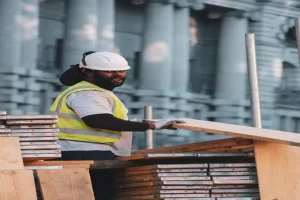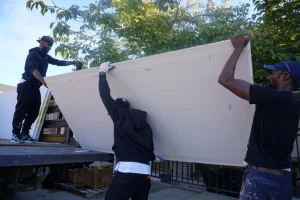Drywall work is a versatile building material utilized to create or cover ceilings and walls. It is available in various constructions and types, including plasterboard, mold-resistant, and VOC-absorbing. Before World War I, most homes had plaster and lath for their wall material. But after the war, the housing boom developed a market for faster finishing walls, and drywall work was invented. Nowadays, it is the primary finish material for interior walls.
Drywall is a building material utilized to cover framing on walls and ceilings. It is made from gypsum, which is a naturally rising mineral making it an eco-friendly option. The gypsum is blended with added materials to build a slurry that is sandwiched between two layers of paper and then dried. The type of paper and thickness, with the chemicals in the slurry, specify the type of drywall. Drywall is also known as gypsum board, wallboard, and sheetrock.
Drywall supplies fire resistance and soundproofing for ceilings and walls on the interior of commercial and residential buildings. First, it is screwed into the framing structure where the joints between drywall panels are taped to cover up the gap, then mud is spread to smooth the transition and mend the screw holes. Once the mud dries, it is sanded to a fine finish, and the wall is painted or textured, depending on the desired drywall finish.

Drywall arrives in a variety of thicknesses, each utilized in different applications. Numerous layers of drywall can be installed to improve soundproofing and fire resistance qualities. The thinnest board is one-fourth inch, mainly used on curved walls. Its thinness enables it to be more flexible, particularly when wet. Once the drywall is dry, it is finished like regular drywall work.
The typical thickness of drywall is half an inch. This is utilized on the majority of walls in commercial and residential construction. It provides thirty minutes of fire protection. Several layers are frequently installed in rooms or areas that require more protection. For more soundproofing or fire resistance, ⅝ inch drywall can be utilized. It provides sixty minutes of fire resistance and is installed in layers to give more protection.
Numerous types of drywall are generally differentiated by the color of the paper around the drywall patch. In addition, different paper kinds and adding chemicals in the slurry create deviations.
This whiteboard drywall is the most common kind used in walls and ceilings in homes and commercial projects. The standard thickness for residential usage is half an inch. The most common drywall sheet extent is 4’ x 8’, but it is also available in sizes up to 16’ for high ceilings.
This drywall is known as a green board. It is created with a paper backing thicker than typical drywall and coated with wax for additional moisture resistance. It also arrives with a fiberglass mesh that is non-organic, extracting the food necessary for mold to develop. Mold-resistant drywall is most frequently used in the kitchen, bathrooms, and laundry rooms and as a tile backer.
Plasterboard, also known as the blue board, is utilized as a base for plaster applications, like the lath in plaster walls. Plasterboard needs a thin coat or coats of plaster to be established over the entire surface. The face paper is absorbent, enabling the plaster finish drywall coat to attach to the drywall better. It is used in older homes to give the look of plaster and lath.
As all drywall has some soundproofing qualities, this drywall adds extra gypsum, wood fiber, and polymers to improve the sound transmission class above that of regular drywall. Soundproof drywall is utilized when additional soundproofing is needed, like between shared walls and living spaces. However, it is denser than regular drywall repair and can be more tricky to work with.

The fire-resistant drywall is utilized in basements and garages around equipment that might result in a fire. It includes fiberglass, which slows fire progress and does not burn as fast as regular gypsum.
VOC-absorbing drywall install is a relatively new product, and it captures chemicals and other volatile organic mixtures and traps them within the drywall. These chemicals arrive from other building materials and cleaning products used daily.
Read More
1 thought on
I am from the North Philadelphia area, would I be able to get a good job post this Drywall program?